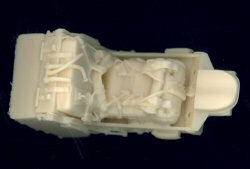
Avionix 1/32 F-100D Super Sabre Cockpit First Look
By Michael Benolkin
| Date of Review | June 2007 | Manufacturer | Avionix |
|---|---|---|---|
| Subject | F-100D Super Sabre Cockpit Set | Scale | 1/32 |
| Kit Number | 32045 | Primary Media | Resin |
| Pros | Late configuration cockpit | Cons | Soft details in places, no provision to remove parachute from ejection seat (see text) |
| Skill Level | Intermediate | MSRP (USD) | Out of Production |
First Look
 |
 |
 |
 |
 |
Avionix, formerly Black Box and Combat Series, is still turning out some interesting aftermarket detail sets for new releases as well as 'classic kits'. The beautiful cockpit for Hasegawa's 1/32 TA-4J Skyhawk being an excellent example of the latter.
In this much-anticipated release, Avionix was able to obtain a test shot of the Trumpeter 1/32 F-100D Super Sabre kit and design an intricate aftermarket cockpit to drop into place. A look at the cockpit layouts on our F-100.org website reveals that Avionix patterned their cockpit after the late configuration cockpit while Trumpeter used patterned the kit cockpit after the early configuration.
The detailing on the side consoles looks accurate for the late configuration, though the detailing is a bit soft in contrast to the instrument panel.
The instrument panel looks accurate for configuration, though my example seems to have problems with the round bezels on the instruments and the edge of the glare shield simply stops at the parabrake handle rather than going over the top of it.
One minor note: I've seen references to HUD in the instructions and elsewhere. The F-100 never had a HUD. None of the Century Series were equipped with HUDs. The first HUDS appeared in the 1970s with the A-7 Corsair II, F-14 Tomcat and F-15 Eagle. The F-100 was equipped with a gunsight.
My biggest gripe with this cockpit set is the ejection seat. The detailing on it is up to Avionix's high standards, but for some odd reason, they molded a parachute pack integral with the seat. There is no good way to remove that parachute. Why is this an issue? In USAF service, the parachute was stored and maintained in the life support shop. You didn't leave these critical items to the safety of the pilot sitting in the cockpit. I can't speak to the operational practices for parachutes left in the cockpits of F-100s in French, Taiwan, Turkish or Danish service. Note: The Danish AF did retrofit some of their F-100Ds with a Martin Baker ejection seat.
Where the Martin-Baker seats (like the F-4's seats) kept the parachutes integral with the seat so when you strapped into the seat, you strapped on the parachute at the same time. In the F-100, the pilot dons the parachute in the building, carries his equipment out to the aircraft, climbs into the cockpit, then straps into the seat. When exiting the aircraft, the pilot typically is still wearing the chute and removes it at the bottom of the boarding ladder and takes it back to the rack inside the ops building. In short, you would rarely see a parachute sitting on the ejection seat as depicted here without a pilot attached to it. I hope Avionix (or someone) will do this seat sans the chute.
One other interesting deviation is the cover that is molded around the gunsight behind the windscreen. This area was bare on USAF operational F-100s. This may have been applied to the F-100 in non-US service, but this is incorrect for the USAF and ANG F-100D.
While I am a big fan of the Black Box, Combat Series, and Avionix products, I can't give this release a glowing recommendation. If you're convinced that the stock Trumpeter cockpit is not right for you, this is one option. I suspect others will be forthcoming. I will use this cockpit tub and some of the details provided in the set, but I'll be working with the kit's ejection seat as there will be no easy way to get that parachute out of the Avionix seat.







